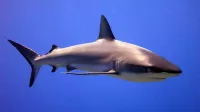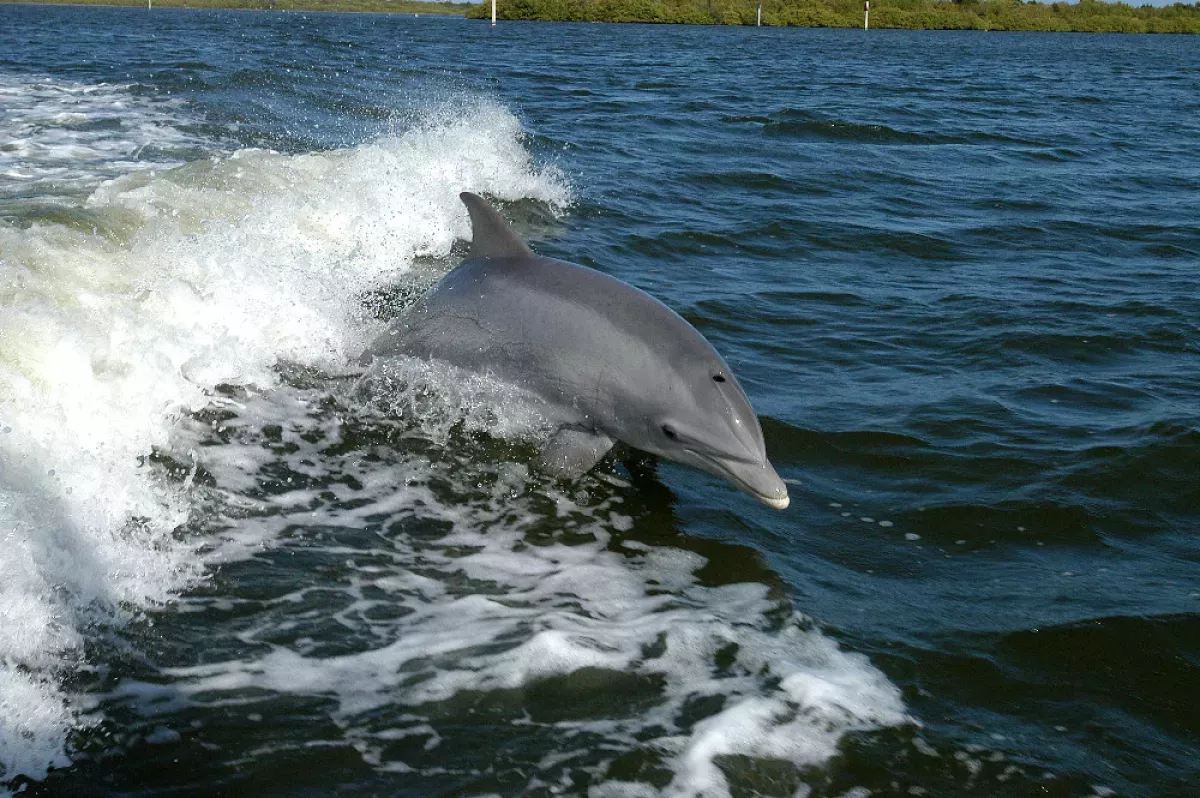Dolphins are aquatic mammals belonging to the cetacean clade Odontoceti. They are grouped into families such as Delphinidae, Platanistidae, Iniidae, and Pontoporiidae, with the possibly extinct Lipotidae also considered. Currently, there are 40 recognized extant dolphin species. As mammals, they share characteristics like breathing air, being warm-blooded, and nursing their young, distinguishing them from fish. Their intelligence and social behavior have made them subjects of scientific study and popular culture interest.
1933: Hybrid Dolphins Beached
In 1933, three hybrid dolphins, a cross between Risso's and bottlenose dolphins, were found beached off the Irish coast, indicating natural hybridization in the wild.
1962: Start of Queensland's Shark Culling Program
Since 1962, Queensland's shark culling program has killed roughly 50,000 sharks, and has also resulted in the deaths of thousands of dolphins as bycatch.
1976: Dolphin Depicted Naturalistically in Poole
Since 1976, the dolphin in the coat of arms of the town of Poole, Dorset, England, first recorded in 1563, has been depicted naturalistically, rather than in a stylised heraldic form.
1982: El Niño Warming Event Affects Marine Life
In 1982, the 1982–83 El Niño warming event caused the near-bottom spawning market squid to leave southern California, which caused their predator, the pilot whale, to also leave.
1984: Increase in Pacific White-Sided Dolphin Occurrence
From 1984 to 1998, the Pacific white-sided dolphin had an increase in occurrence on the west coast of Canada.
1985: First Wholphin Born in Captivity
In 1985, the first wholphin, a hybrid of a false killer whale and a bottlenose dolphin, was born at Sea Life Park in Hawaii, born from a male false killer whale and a female bottlenose dolphin.
1988: Billie Learns Tail-Walking
In 1988, a female dolphin named Billie, after recuperating with captive dolphins at a marine park and observing them tail-walking, began performing the trick herself after being released back into the Port River.
1991: Tilikum's First Incident
In 1991, Tilikum played a role in the death of a person, which was the first of three different incidents.
1992: Tilikum at SeaWorld
A male orca named Tilikum, who was involved in multiple fatal attacks on humans, lived at SeaWorld from 1992 until his death in 2017.
1992: Dolphin Range Shifts in Northwest Scotland
From 1992 to 2003, in northwest Scotland, white-beaked dolphins decreased while common dolphins increased due to warmer waters.
1995: Television Used to Test Dolphin Self-Awareness
In 1995, Marten and Psarakos used television to test dolphin self-awareness, using real-time video, video of other dolphins, and recorded footage. The study concluded that the evidence suggested self-awareness rather than social behavior.
1996: Fraser's Dolphin Recorded in the UK
In 1996, Fraser's dolphin, a species found in tropical waters, was recorded in the UK for the first time, indicating a range shift.
1998: Increase in Pacific White-Sided Dolphin Occurrence
From 1984 to 1998, the Pacific white-sided dolphin had an increase in occurrence on the west coast of Canada.
1999: Captive-Born Orcas on Display
By 1999, about 40% of the 48 animals on display in the world were captive-born.
1999: Tilikum's Second Incident
In 1999, Tilikum played a role in the death of another person.
2003: Dolphin Range Shifts in Northwest Scotland
From 1992 to 2003, in northwest Scotland, white-beaked dolphins decreased while common dolphins increased due to warmer waters.
2003: Short-Beaked Common Dolphin Endangered
In 2003, the short-beaked common dolphin Mediterranean subpopulation was deemed endangered due to increased sea surface temperatures, salinity, upwelling intensity, and sea levels reducing prey resources.
May 2005: Dolphins Teach Tool Use
In May 2005, researchers in Australia discovered that Indo-Pacific bottlenose dolphins (Tursiops aduncus) teach their young to use tools, such as covering their snouts with sponges while foraging, marking the discovery of cultural behavior among dolphins.
October 2006: Dolphin with Vestigial Hind Limbs
In October 2006, a bottlenose dolphin with small fins on each side of its genital slit was captured in Japan. Scientists believed that these fins are an unusually pronounced development of vestigial hind limbs.
2006: Yangtze River Dolphin Functionally Extinct
In 2006, a survey found no individuals of the Yangtze river dolphin, leading to the conclusion that the species is now functionally extinct.
2007: Spindle Neurons Found in Dolphin Brains
Prior to 2007, elongated spindle neurons, known for their role in social conduct and emotions in humans, were discovered in the neocortex of many dolphin species, suggesting similar cognitive functions.
2007: Dolphins Use Shelling to Catch Fish
Starting in 2007, researchers observed dolphins in Shark Bay, Australia, using "shelling" to catch fish by trapping them in huge conch shells. The dolphin brings the shell to the surface and shakes it, so that fish sheltering within fall into the dolphin's mouth.
2009: Wall Painting Fragment Depicting Dolphins Found
During the 2009 excavations of a major Mycenaean city at Iklaina, a striking fragment of a wall painting came to light, depicting a ship with three human figures and dolphins.
2010: Tilikum's Third Incident
In 2010, Tilikum played a role in the death of a third person, which later sparked the production of the documentary Blackfish.
2011: Decline in Dolphin Population
In 2011, a marine heatwave caused a decline in prey which led to a decline in dolphin reproductive rates as female dolphins could not get enough nutrients to sustain a calf. This occurred at the Shark Bay World Heritage Area in Western Australia, affecting the local Indo-Pacific bottlenose dolphin population.
2011: Tail-Walking Observed in Dolphin Group
In 2011, up to 12 dolphins were observed tail-walking, but only females appeared to learn the skill.
2014: Dolphin Deaths in Queensland
At least 32 dolphins have been killed in Queensland since 2014 due to the "shark control" program.
2017: Orcas in Captivity
As of 2017, there were 60 orcas kept in captivity in aquaria, a small number compared to the number of bottlenose dolphins.
2017: Death of Tilikum
Tilikum, an orca who played a role in the death of three people, died at SeaWorld in 2017.
2018: Study on Dolphin Tail-Walking
A 2018 study by Mike Rossley et al. focused on the spread of tail-walking behavior among dolphins and noted that the spread of this behaviour, through up to two generations, is surprising, as it brings no apparent advantage, and is very energy-consuming.
2018: Dolphin Shelling Observed in Shark Bay
From 2007 to 2018, researchers observed 19 dolphins shelling 42 times. The behavior spreads mainly within generations, rather than being passed from mother to offspring.
October 2021: Dolphin Observed Tail-Walking
In October 2021, a dolphin was observed tail-walking over a number of hours.
Mentioned in this timeline
California is a U S state on the Pacific Coast...
Japan is an East Asian island country situated in the...
Australia officially the Commonwealth of Australia encompasses the Australian mainland...
Argentina officially the Argentine Republic is located in the southern...

Sharks are cartilaginous fish belonging to the group Selachii characterized...
Canada is a North American country the second largest in...
Trending

1 month ago Bitwise Launches XRP ETF Amidst Market Activity; XRP Staking Explored.
The Topps Company is an American manufacturer of trading cards and collectibles most notably known for its baseball and other...
2 months ago Medicaid Cuts Threaten Rural South: Residents Brace for Impact on Healthcare Access

8 months ago George Wendt, 'Cheers' Star, Remembered Fondly After Death; Sudeikis Shares Memory

Daisy Ridley is an English actress widely recognized for her portrayal of Rey in the Star Wars sequel trilogy which...

1 month ago Cam Newton Reacts to Drake Maye's Taunt; Patriots Champ Rips Newton's Criticism.
Popular

Stranger Things created by the Duffer Brothers is a popular...

XXXTentacion born Jahseh Dwayne Ricardo Onfroy was a controversial yet...

Kelsey Grammer is an accomplished American actor producer and singer...

Candace Owens is an American conservative political commentator and author...
Turning Point USA TPUSA is an American nonprofit organization founded...

Bernie Sanders is a prominent American politician currently serving as...
